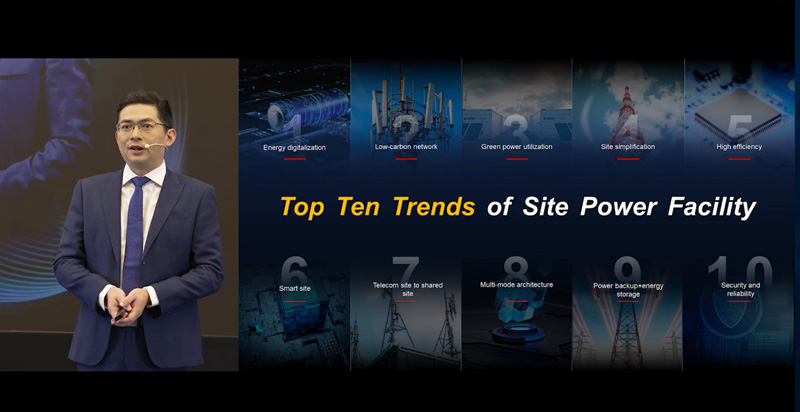[2022 December 29, Shenzhen] Huawei held the Top 10 Site Power Trends online release conference and launched a white paper. Yao Quan, President of Huawei Site Power Facility Domain, unveiled the ten trends at the event.
According to Yao, 2022 is a challenging year for carriers. Oil prices and electricity fees keep surging in the context of global energy crisis. Carriers' OPEX increases sharply, and site power innovation is high on the agenda. Against this backdrop, Huawei shares the top ten trends of site power, aiming to work with industry partners and promote site power towards simple, green, and intelligent, and help carriers achieve network carbon neutrality.
 Yao Quan, President of Huawei Site Power Facility Domain
Yao Quan, President of Huawei Site Power Facility Domain
Trend 1: Energy digitalization
Since a global consensus on carbon neutrality has been reached, the ICT sector has been striving to go green (Green ICT) and enabling other sectors to go green (ICT for Green). To realize these, Huawei integrates digital technologies and power electronics technologies and let bits manage watts, thereby promoting the green and low-carbon transformation of the ICT and other sectors. In the foreseeable future, energy digitalization will penetrate into more domains and boost carbon reduction in different industries.
Trend 2: Low-carbon network
ICT drives social progress and improves people's quality of life. However, ICT network evolution spawns power consumption surge and carbon emission issues. To cope with the energy crisis and realize carbon neutrality, carriers seek to build a green and low-carbon network throughout the lifecycle from network construction, power supply, to operation.
During network construction, site structure is simplified and changed from equipment rooms and cabinets to poles, curtailing carbon emissions during network construction. In terms of power supply, a PV system is mounted on sites to maximize PV power utilization and reduce grid power consumption. As for operation, site digitalization helps perform intelligent O&M, reducing manual site visit. Sites with abnormal energy consumption and carbon emissions can be pinpointed in real time, further reducing site O&M costs and carbon emissions.
Trend 3: Green power utilization
In the past, grid power and diesel generator are the main power sources for sites, and green power accounts for only about 1% in the energy mix. As new energy technologies develop and new business models emerge, site power supply becomes diversified and more of clean energy such as solar energy, wind energy, and hydrogen is utilized. Since the electricity price and oil price keep increasing and the cost of clean energy further decreases, carriers will raise the proportion of self-built green power plants besides PPA.
Trend 4: Site simplification
Conventional sites are often deployed in equipment rooms or cabinets, in which air conditioners consume large amount of energy, causing low efficiency and high electricity fees. In the 5G era, the number of sites increases sharply, and the construction cost soars. The conventional mode is unsustainable. Site structure needs to be simplified and changed from rooms to cabinets and poles, thereby reducing energy consumption and carbon emissions.
Trend 5: High efficiency
Efficiency optimization is no longer confined to components. Site energy efficiency (SEE) is evaluated to realize high efficiency during site deployment and collaboration of power supply link and main devices.
In terms of site structure, the SEE can be raised to 97% after sites are deployed in cabinets or on poles. Besides, site footprint is also cut.
As for power supply's efficiency, the focus changes from rectifiers to the link of generation, conversion, storage, distribution, and consumption. Wide-bandgap semiconductor materials and digital technologies drive the development of highly efficient and intelligent site power supplies.
In addition, power electronics technologies are integrated with digital technologies, and energy devices and wireless devices are coordinated to implement precise energy efficiency management and energy consumption optimization.
Trend 6: Smart site
Conventional sites usually adopt dumb components, which do not support refined management. Energy consumption and carbon emission of sites cannot be viewed, and energy saving and carbon reduction cannot be performed. Besides, site maintenance highly relies on manual site visits, resulting in high O&M costs. All these issues will be eliminated after we resort to intelligent site management and automatic O&M. Energy efficiency and carbon emission data can be displayed in real time, further improving site operation efficiency.

Trend 7: Telecom site to shared site
Massive communication sites have huge business opportunities In the past, site resources were wasted due to service mode limitation. In the future, telecom sites will become shared sites and supply power to the public users. Telecom carriers will change to integrated service providers. Site service modes will be more diversified. For example, new services such as virtual power plant (VPP), electricity access with the network, and rent offset with electricity can be provided to increase site revenues and unleash the values of telecom sites.
Trend 8: Multi-mode architecture
As more types of power sources are used, site power must be able to support different input modes. In addition, shared sites need to meet power supply requirements of different loads. Therefore, multi-mode output is required. Multi-mode architecture will become the mainstream to support different input and output modes.
Trend 9: Power backup+energy storage
In traditional telecom sites, energy storage only provides backup power for communications equipment and is idle in most of the time. As time-of-use tariff is used in more areas, carriers start to develop new business models such as peak staggering and VPP. Energy storage participates in power grid scheduling. Site batteries develop from backup power to an integrated energy storage system. For carriers, idle assets can be activated to generate more revenues and save electricity fees. For power grids, energy storage is an additional guarantee for grid stability.
Trend 10: Security and reliability
For sites, security and reliability refer to network security and hardware safety. As energy digitalization gains momentum, governments and industries are working to prevent attacks and security risks. A series of security and safety specifications are released.
Grasp the trends to win the future. Huawei looks forward to working with the industry and builds a low-carbon target network for site power, accelerating the achievement of network carbon neutrality.
White Paper on Top 10 Site Power Trends:
https://digitalpower.huawei.com/attachments/index/0164454533db4b01a02d144ae0eb209d.pdf

 Search
Search




 Search
Search


